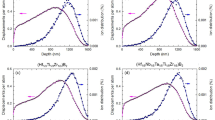Abstract
A general model for the e-beam induced decomposition of covalent and ionic inorganic solids is outlined. The primary electron beam produces energetic electron/hole pairs; these decay to the band edges, and either recombine or participate in the chemical decomposition of the solid. The kinetics and mechanism of several systems is discussed, including CdCl2 and PbI2. The importance of temperature in decomposition is remarked and it is suggested that induced decomposition mostly starts at 0.6 melting point (K). The usefulness of various inorganic systems, as resists, for x-ray masks, for local indiffusion sources and for metal inter-connects is noted
Access this chapter
Tax calculation will be finalised at checkout
Purchases are for personal use only
Preview
Unable to display preview. Download preview PDF.
Similar content being viewed by others
Reference
Albrecht MG & Green M: J Phys Chern Solids, 38 (1977) 297.
Albrecht MG: Photolysis of Lead Iodide. PhD Thesis, University of London (1975).
Green M & Albrecht MG: Thin Solid Films, 37 (1976) L57.
Kuku TA: Photolysis of Tin Di-iodide, PhD Thesis, Universi ty of London.
Green M & Kuku TA: J Phys Chern Solids,44 (1983) 999.
Kuku TA & Green M: Thin Solid Films, 144 (1986) L119.
Green M, Aidinis CJ & Fakolujo OA: J App Physics, 57 (1985) 631.
Aidinis CJ: Cadmium Chloride as an Electron Beam Resist. PhD Thesis, University of London (1987).
Green M & Lane SJ: Photolysis of Iodides of Ga, Al and As. Submitted for publication.
Green M & Fakolujo OA: E-beam induced decomposition of PbCl2 and related systems, to be published.
Green M & Khaleque F: E-beam induced decomposition of CsCl, submitted for publication.
Klein AC: J Appl Phys, 39 (1967) 2029.
Brodie I & Muray JJ: The Physics of Micro Fabrication, Plenum, New York (1982)
Author information
Authors and Affiliations
Editor information
Editors and Affiliations
Rights and permissions
Copyright information
© 1988 Martinus Nijhoff Publishers
About this chapter
Cite this chapter
Green, M., Aidinis, C., Fakolujo, O. (1988). E-Beam Induced Decomposition of Inorganic Solids. In: Ehrlich, D.J., Nguyen, V.T. (eds) Emerging Technologies for In Situ Processing. NATO ASI Series, vol 139. Springer, Dordrecht. https://doi.org/10.1007/978-94-009-1409-4_14
Download citation
DOI: https://doi.org/10.1007/978-94-009-1409-4_14
Publisher Name: Springer, Dordrecht
Print ISBN: 978-94-010-7130-7
Online ISBN: 978-94-009-1409-4
eBook Packages: Springer Book Archive




